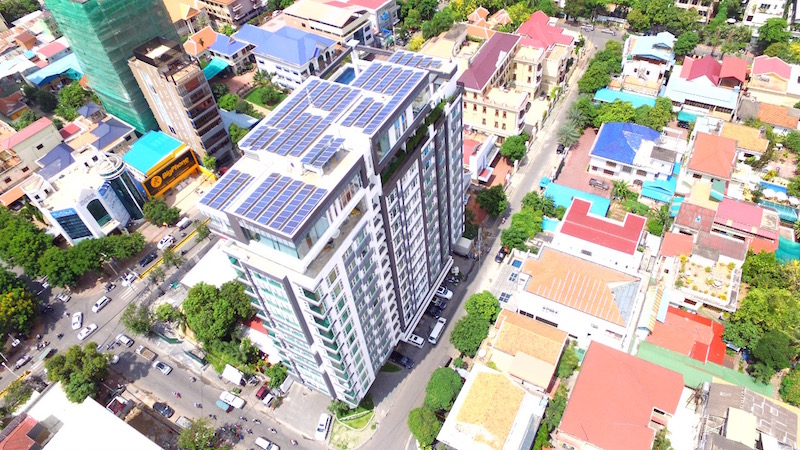In Phnom Penh, atop a 15-story serviced apartment building, workers wearing harnesses, face masks and baseball caps put the finishing touches on a rooftop solar panel system earlier this year.
Working through January, the builders completed a 68-kilowatt system for Silvertown Metropolitan building, a high-end, 110-unit residential block looking over the expatriate- and luxury-oriented Boeng Keng Kang I commune in Chamkar Mon district.

The panel now supplies about 20 to 25 percent of the apartment building’s electricity needs, according to Thorng Daravuth, Silvertown’s general manager.
In a leasing arrangement, the building takes a cut of about 10 percent of the electricity bills paid by tenants, and passes the rest on to Kamworks, one of the oldest solar companies in Cambodia, which paid for and installed the $66,000 system.
“We didn’t need to pay a big cost upfront,” Mr. Daravuth explained. “We’re still discussing a contract for how many years to pay off the total cost of the installation.”
The solar panel covers about $2,000 of the building’s roughly $10,000 a month electricity bill, he added.
The arrangement is one of several new ways solar is expanding throughout Cambodia. An increasing number of firms are installing large-scale systems to help power factories and residential high-rises, taking advantage of solar’s positive environmental image and the savings possible compared to the high cost of the country’s grid-supplied power.
Arjen Luxwolda, board member for the Solar Energy Association Cambodia and managing director of Kamworks, said the sector divided broadly into two markets: one focused on off-the-grid rural areas where customers use solar panels to charge household batteries; and urban sectors that already have electricity access but are seeking to reduce high electricity costs.
The latter market, in particular, is driving growth as solar panels become more affordable, Mr. Luxwolda said.
“The grid-connected market is now slowly opening because of the drop in the price of equipment. And the high electricity price in Cambodia makes it feasible—economically viable—to use solar on rooftops,” he said.
According to the Asian Development Bank (ADB), Cambodia’s energy costs are inflated by its power infrastructure, which has been dominated by isolated, inefficient generation and distribution systems powered by diesel and heavy fuel oil, despite growth in electricity imports from neighboring countries and an increase in hydropower generation.
Ken Bradley, director of business development at Kamworks, agreed that most of the firm’s clients were looking for ways to reduce their electricity costs. He added that households and businesses could recoup their initial investments in three to five years.
“Systems will cover 35 to 50 percent [of energy needs] depending on how the family manages their electricity usage,” he said. Installations typically cost between $4,000 and $12,000 for households and potentially into the millions for large businesses, he added.
John McGinley, managing partner at the investment and advisory firm Mekong Strategic Partners, said the sector is ripe with potential.
“From the perspective of the private sector, the market signals from investors all over the world are crystal clear; they are actively seeking out opportunities to invest in solar energy and are actively divesting from and have no interest in investing further into traditional generation assets, such as coal,” he said. “Cambodia is ideally suited for solar energy from many perspectives.”
The country’s first large-scale solar power farm is currently under construction near Bavet City in Svay Rieng province, and expected to be completed in the coming months. The 10-megawatt, $9.2-million project, developed by Singaporean solar firm Sunseap and funded by a loan from the ADB, is expected to supply roughly a quarter of Bavet City’s electricity needs.
This week, the ADB and Cambodia’s state-run energy utility, Electricite du Cambodge (EDC), announced plans to set up a 100-MW national solar park program, including the Bavet City project. The program will be implemented with a 30-MW first phase followed by 70 MW in phase two, the two parties said in a statement.
Meanwhile, Singapore-based Cleantech Solar, which specializes in commercial and industrial solar, recently installed solar panels at the newly opened, $100 million Coca-Cola factory in the Phnom Penh Special Economic Zone.
However, significant challenges remain.
According to Mr. Luxwolda, Cambodia lacks a regulatory framework under which solar customers can sell excess electricity back to the grid.
Such a policy has been key to promoting the adoption of solar elsewhere in the world, by allowing customers to get consistent returns on their investment.
“At this moment, we can only install solar for customers that can use all the power generated by the solar system themselves. If the solar produces more power than a customer is using, it will go back to EDC and it will be lost,” Mr. Luxwolda said.
“The market is quite limited. You need to find companies that have seven days a week operation, for example, [so they don’t lose] the power for Saturday or Sunday,” he said.
Tin Ponlok, secretary-general of the National Council for Sustainable Development, also raised the net metering issue as an obstacle to wider adoption.
“As a general government policy framework, we are still in the process of research—especially in the case of net metering, for those rooftop solar users to be able to subsidize remaining electricity back to EDC,” Mr. Ponlok said.
The priorities should be to solve regulatory challenges, set clear targets and provide tax incentives, said Fiona Lord, Cambodia country representative of the Global Green Growth Institute.
Cambodia should take advantage of the drop in solar equipment costs and maximize its solar potential, Ms. Lord said.
“Furthermore, establishing quality control schemes in Cambodia for imported solar products would help to retain consumer confidence in the renewable energy market,” she added.
(Additional reporting by Matt Surrusco)



